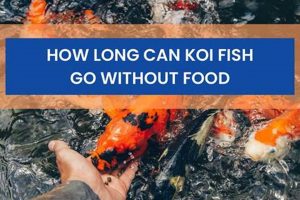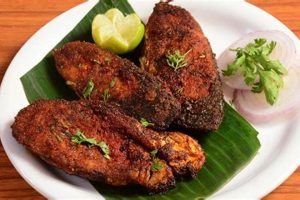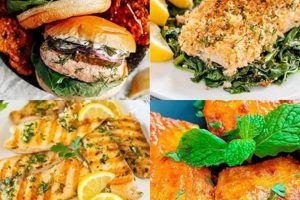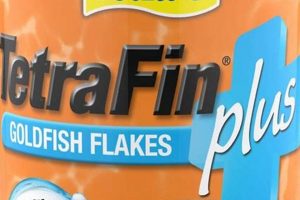The dietary requirements of dwarf puffers, also known as pea puffers, necessitate small, invertebrate-based meals. These tiny freshwater fish possess unique feeding habits and preferences, requiring specialized sustenance to thrive in a captive environment. This typically consists of small live or frozen foods.
Providing suitable nutrition is paramount to the health and well-being of these miniature predators. A varied and appropriate diet ensures proper growth, vibrant coloration, and disease resistance. Historically, hobbyists have relied on live foods to meet these needs, but frozen alternatives are increasingly available and accepted.
Understanding the specifics of suitable offerings is essential for responsible care. The following sections will delve into the various types of acceptable items, preparation methods, and feeding schedules to promote optimal health and longevity.
Essential Guidance for Dwarf Puffer Nutrition
Optimizing the dietary regimen for dwarf puffers is critical to their health and longevity. Adhering to the following recommendations will assist in ensuring adequate nutrition.
Tip 1: Prioritize Live Foods: While frozen alternatives exist, live offerings such as bloodworms, daphnia, and brine shrimp often elicit a stronger feeding response from dwarf puffers. This is particularly important for newly acquired or finicky individuals.
Tip 2: Ensure Size Appropriateness: Dwarf puffers possess small mouths; therefore, food items must be appropriately sized. Grindal worms and microworms are excellent options for smaller specimens or juveniles. Larger offerings should be chopped or divided accordingly.
Tip 3: Vary the Diet: A varied diet is crucial for providing a full spectrum of nutrients. Regularly alternate between different live and frozen options to prevent nutritional deficiencies and maintain interest in feeding.
Tip 4: Observe Feeding Behavior: Closely monitor the puffers during feeding to ensure all individuals are receiving adequate sustenance. Some individuals may be more assertive feeders than others, requiring targeted feeding.
Tip 5: Avoid Overfeeding: Dwarf puffers are prone to obesity if overfed. Offer small portions once or twice daily, ensuring all food is consumed within a few minutes. Remove any uneaten food promptly to maintain water quality.
Tip 6: Gut Load Live Foods: Prior to feeding live items, “gut load” them with nutritious supplements. This enhances their nutritional value and provides additional benefits to the puffers. Commercially available gut-loading products are available.
Tip 7: Consider the Use of Snails: Small snails, such as ramshorn or bladder snails, can serve as a supplementary sustenance source and aid in maintaining beak health. Puffers naturally consume the snails, helping to prevent overgrown beaks.
Consistent application of these guidelines will contribute significantly to the overall health and well-being of dwarf puffers, promoting vibrant coloration, robust growth, and increased resistance to disease.
The subsequent sections will explore common feeding challenges and potential solutions, offering a comprehensive understanding of dwarf puffer nutrition.
1. Live Foods and Dwarf Puffer Nutrition
Live foods represent a crucial component in the dietary regimen of pea puffers ( _Carinotetraodon travancoricus_). The innate predatory instincts of these fish are strongly triggered by the movement and presence of living prey. This stimulation translates into a more enthusiastic feeding response compared to inert, non-living alternatives. A direct consequence of readily accepting sustenance is improved overall health, manifesting in enhanced coloration, increased activity levels, and greater resistance to disease. Without the inclusion of live components, some individuals may refuse to feed entirely, leading to malnutrition and, ultimately, mortality. Examples of suitable live offerings include bloodworms, daphnia, brine shrimp, and microworms, each providing varying nutritional profiles beneficial to the fish.
The benefits of incorporating live meals extend beyond mere acceptance. The act of hunting and capturing live prey provides mental stimulation for pea puffers, enriching their captive environment. This behavior mimics their natural foraging habits in the wild, promoting psychological well-being. Furthermore, live items often contain beneficial enzymes and microorganisms that aid in digestion and nutrient absorption, contributing to a healthier gut microbiome. The selection of live food type can also address specific nutritional needs. For instance, gut-loaded brine shrimp can deliver vitamins and supplements directly to the fish, optimizing their nutritional intake. Regularly using live offering is important for pea puffer health and vitality.
In conclusion, the integration of live foods into the diet of pea puffers is not merely a preference but a necessity for their optimal health and well-being. While frozen or prepared offerings can supplement their diet, the inclusion of live items is paramount to stimulating feeding behavior, promoting mental enrichment, and ensuring adequate nutrient intake. Addressing the challenges associated with sourcing and maintaining live food cultures is a worthwhile investment for any aquarist dedicated to the responsible care of these captivating fish. This understanding underscores the importance of replicating, as closely as possible, the natural feeding patterns of pea puffers in their native environment.
2. Frozen
Frozen food represents a convenient and readily available alternative to live sustenance for pea puffers. While live options are often preferred to stimulate feeding, frozen items offer practicality and ease of storage, making them a valuable component of a well-rounded dietary plan.
- Nutritional Retention
The process of freezing can preserve a significant portion of the nutritional content present in live organisms. However, some degradation of vitamins and essential fatty acids may occur. Selecting high-quality frozen products and supplementing with vitamin additives can mitigate these losses.
- Reduced Risk of Parasites and Pathogens
Compared to live sources, frozen food generally carries a lower risk of introducing parasites or harmful pathogens into the aquarium. This is particularly beneficial for maintaining a healthy and stable aquatic environment. Proper thawing techniques are essential to prevent contamination.
- Variety and Accessibility
The range of frozen items available for aquarium fish is extensive, encompassing bloodworms, brine shrimp, daphnia, mysis shrimp, and more. This variety allows aquarists to offer a more balanced diet to their pea puffers, catering to their diverse nutritional needs. Frozen food is also easily accessible from most pet stores.
- Proper Thawing Procedures
Correctly thawing frozen food is crucial to preserve its quality and prevent water pollution. The recommended practice involves thawing a small portion in a cup of aquarium water before feeding. Discarding any excess water minimizes the introduction of unwanted nutrients into the tank, contributing to better water quality.
The strategic use of frozen nutrition provides a practical and safe means of meeting the dietary requirements of pea puffers. While live sustenance remains advantageous, the convenience and accessibility of frozen options make them an indispensable tool for responsible aquarists, ensuring the sustained health and well-being of these captivating fish. Supplementation with live food options is recommended where possible to ensure balanced nutrition and stimulate natural feeding behaviors.
3. Variety
The concept of dietary variety is paramount in maintaining the health and well-being of pea puffers. Due to their specific nutritional needs and inherent feeding preferences, a monotonous diet can lead to deficiencies and diminished vitality. Implementing a diverse feeding strategy addresses these concerns and promotes optimal health.
- Nutritional Completeness
Offering a range of foods ensures a broader spectrum of nutrients is available. Different food sources contain varying levels of proteins, fats, vitamins, and minerals. A singular food item is unlikely to provide all essential elements in sufficient quantities. For instance, bloodworms are a good source of protein but may lack certain micronutrients abundant in daphnia.
- Stimulating Natural Behaviors
Pea puffers are natural predators. Providing a variety of live and frozen offerings mimics their natural hunting behavior. This mental stimulation prevents boredom and encourages activity, contributing to their overall psychological well-being. Introducing different textures and tastes keeps their interest piqued and prevents food refusal.
- Mitigating Potential Deficiencies
A restrictive diet can lead to specific nutrient deficiencies, resulting in health problems. For example, prolonged reliance on a single frozen item may lead to vitamin deficiencies. Regular alternation between different food types helps to prevent these imbalances and ensures a more complete nutritional profile.
- Preventing Dietary Boredom
Like many animals, pea puffers can become bored with a repetitive diet. This boredom can manifest as decreased appetite or complete food refusal. Introducing new and interesting food items maintains their enthusiasm for feeding, ensuring they receive adequate sustenance.
In conclusion, variety in sustenance selection is not merely a suggestion but a necessity for responsible pea puffer care. By providing a diverse array of appropriate offerings, aquarists can address nutritional needs, stimulate natural behaviors, prevent deficiencies, and combat dietary boredom. This multifaceted approach contributes significantly to the health, vitality, and longevity of these captivating fish, reinforcing the importance of thoughtful and informed feeding practices.
4. Size
The dimensions of sustenance are of paramount importance in the successful feeding of pea puffers. Due to their small stature and correspondingly diminutive mouthparts, these fish are incapable of consuming larger food items. Providing offerings that exceed their capacity results in feeding frustration, malnutrition, and potential starvation. Therefore, careful consideration must be given to matching food size with the puffer’s physical limitations.
- Optimal Ingestion
Food particles must be small enough to be easily ingested. If the portions are too large, the puffer will be unable to swallow them, leading to wasted effort and potential stress. Ideally, the size should be proportional to the puffer’s head size, ensuring easy manipulation and ingestion.
- Choking Hazards
Offering food items that are too big can pose a choking hazard. Pea puffers lack the dentition necessary to break down large pieces. Attempting to consume oversized portions can result in blockage and asphyxiation, particularly with hard-bodied organisms.
- Nutrient Availability
Even if a puffer can partially ingest an oversized item, the available nutrients may not be efficiently absorbed. The surface area exposed to digestive enzymes is reduced, limiting the breakdown and absorption of essential compounds. Smaller pieces offer a greater surface area for digestion, maximizing nutrient uptake.
- Behavioral Implications
Consistently offering food that is too large can lead to behavioral changes. The puffer may become discouraged from feeding, leading to a loss of appetite and eventual malnutrition. Presenting appropriately sized sustenance promotes a positive feeding response and encourages regular consumption.
In summary, matching sustenance to a pea puffer’s diminutive size is not merely a matter of convenience but a critical factor in ensuring their health and well-being. By providing offerings that are easily ingested and efficiently digested, aquarists can promote optimal nutrition, prevent choking hazards, and encourage positive feeding behaviors. The dimensions of sustenance, therefore, represent a fundamental consideration in the responsible care of these miniature carnivores.
5. Frequency
The regularity with which pea puffers receive sustenance is a critical determinant of their health and well-being. Unlike some fish species that can tolerate infrequent feedings, pea puffers possess a high metabolism and require consistent access to appropriately sized portions.
- Metabolic Demands
Pea puffers are highly active fish with a rapid metabolic rate. This necessitates frequent replenishment of energy reserves to support their activity levels and physiological functions. Infrequent offerings can lead to energy deficits and subsequent health problems.
- Portion Control and Obesity
While frequent feedings are necessary, portion control is equally important. Pea puffers are prone to overeating, which can lead to obesity and related health complications. Small, frequent meals are preferable to larger, less frequent ones. Observing the puffer’s body condition is crucial to adjusting the frequency and portion sizes.
- Digestive Efficiency
The digestive system of pea puffers is designed to process small amounts of sustenance at regular intervals. Overloading the digestive tract with large meals can impair digestive efficiency and lead to nutrient malabsorption. Frequent, smaller feedings promote optimal digestion and nutrient uptake.
- Water Quality Considerations
Frequent feedings, if not managed carefully, can contribute to water quality deterioration. Uneaten portions decompose, releasing ammonia and other harmful compounds into the water. Regular maintenance, including water changes and substrate cleaning, is essential to mitigate the impact of frequent feeding on water parameters.
In conclusion, the frequency of feeding pea puffers must strike a balance between meeting their metabolic demands and preventing overeating and water quality issues. Small, frequent meals, coupled with careful observation and diligent tank maintenance, are key to ensuring the long-term health and vitality of these diminutive fish. Consistent adherence to a well-planned feeding schedule is crucial for responsible care.
6. Gut-loading
The practice of gut-loading is a significant consideration when providing sustenance to pea puffers. It directly impacts the nutritional value of live foods offered, thereby influencing the overall health and well-being of these diminutive carnivores.
- Enhanced Nutritional Delivery
Gut-loading involves feeding live items, such as daphnia or brine shrimp, a nutritious diet prior to offering them to the pea puffers. This process effectively transforms the live food into a vessel for delivering essential vitamins, minerals, and fatty acids directly to the fish. For example, daphnia can be gut-loaded with spirulina to increase their vitamin content.
- Targeted Supplementation
Gut-loading allows for targeted supplementation of specific nutrients that may be lacking in the pea puffer’s primary diet. By carefully selecting the food used to gut-load live items, aquarists can address potential deficiencies and ensure a more balanced nutritional intake. For example, gut-loading with carotenoids can enhance the coloration of pea puffers.
- Improved Nutrient Absorption
The digestive processes of live food items can partially break down complex nutrients, making them more readily available for absorption by the pea puffer. This pre-digestion can improve the efficiency of nutrient uptake and reduce the burden on the puffer’s digestive system. Gut-loading can also introduce beneficial enzymes to the pea puffer’s digestive tract.
- Practical Implementation
The gut-loading process is relatively simple to implement. Live food cultures are maintained separately and fed a nutritious diet for a period of 12-24 hours before being offered to the pea puffers. Commercial gut-loading products are available, or a homemade mixture of spirulina, yeast, and fish flakes can be used. Careful monitoring of the gut-loading process is necessary to prevent overfeeding the live food items.
In summary, gut-loading represents a proactive approach to enriching the dietary offerings for pea puffers. By enhancing the nutritional value of live foods, aquarists can promote optimal health, address potential deficiencies, and improve nutrient absorption. This practice is a valuable tool for responsible pea puffer care and contributes significantly to their overall well-being. Therefore, it is integral when providing sustenance to pea puffers.
7. Snails
Snails serve as a dual-purpose component in the dietary management of pea puffers. Primarily, they represent a source of sustenance, contributing essential nutrients to the fish’s diet. Furthermore, their consumption assists in the maintenance of beak health, preventing overgrowth that can impede feeding. Small snail species, such as ramshorn or bladder snails, are typically utilized for this purpose. A controlled introduction of these snails into the aquarium allows the puffers to engage in natural hunting behaviors, enriching their environment and promoting activity. The readily available calcium carbonate in snail shells also contributes to bone and scale health in the pea puffer.
The practical application of utilizing snails extends beyond simple nutritional supplementation. Overgrown beaks, a common ailment in captive puffers, can hinder their ability to consume even appropriately sized portions. Introducing snails provides a natural mechanism for beak trimming, negating the need for potentially stressful manual intervention. The size and type of snail must be carefully considered to prevent injury to the puffer. Overly large or thick-shelled snails may pose a challenge or even cause damage to the puffer’s mouth. Culturing snails separately to ensure a consistent supply is a common practice among experienced keepers. This practice also allows for the snails to be gut-loaded with nutritious food before being introduced into the puffer’s habitat, maximizing the benefits.
In summary, the inclusion of snails in the diet of pea puffers offers a holistic approach to their care. They provide necessary nutrients, contribute to beak maintenance, and promote natural behaviors. Challenges may arise in maintaining a consistent snail population and selecting appropriate species and sizes. Understanding the importance of this connection enhances the responsible husbandry of pea puffers, linking directly to their health and longevity in a captive environment.
Frequently Asked Questions
The following questions address common concerns and misconceptions regarding the dietary needs of pea puffers.
Question 1: What constitutes a suitable primary item?
The optimal primary items are small, invertebrate-based, and either live or frozen. Bloodworms, daphnia, and brine shrimp are commonly accepted options. Live offerings often stimulate a stronger feeding response.
Question 2: How frequently should these fish be fed?
Pea puffers should be fed small portions once or twice daily. Uneaten items should be removed promptly to prevent water quality issues.
Question 3: Is a varied sustenance plan truly necessary?
Yes, dietary variety is crucial. A monotonous plan can lead to nutritional deficiencies. Alternating between different live and frozen options is recommended.
Question 4: What is the purpose of “gut-loading”?
Gut-loading enhances the nutritional value of live items. By feeding the live food a nutritious diet prior to offering it to the puffers, essential nutrients are transferred to the fish.
Question 5: Are snails truly beneficial in the diet?
Snails provide a supplemental item and aid in beak maintenance. The puffers’ natural consumption of snails helps prevent overgrown beaks.
Question 6: Can these fish be overfed?
Yes, pea puffers are prone to obesity if overfed. Strict portion control is essential to prevent health complications.
Understanding these foundational aspects of their nutritional needs contributes significantly to responsible care.
The subsequent section will delve into the challenges and potential solutions associated with feeding pea puffers, offering a comprehensive guide to their dietary management.
Conclusion
The exploration of “pea puffer fish food” has revealed critical aspects of responsible care. Understanding the significance of live and frozen options, dietary variety, size appropriateness, feeding frequency, gut-loading techniques, and the role of snails is essential for maintaining the health and well-being of these diminutive fish. Neglecting these factors can lead to malnutrition, disease, and a diminished lifespan.
Continued adherence to these principles will ensure the sustained vitality of pea puffers in captive environments. Thoughtful and informed feeding practices are paramount for ethical aquarium keeping. It is imperative that aquarists remain vigilant in their commitment to providing appropriate sustenance, thereby contributing to the long-term conservation and appreciation of these captivating creatures.







